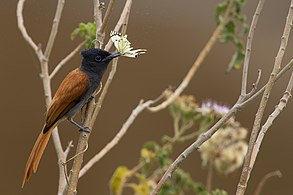African paradise flycatcher
| African paradise flycatcher | |
|---|---|

| |
| male, brown morph | |

| |
| male, white morph | |
| Scientific classification | |
| Kingdom: | |
| Phylum: | |
| Class: | |
| Order: | |
| Family: | |
| Genus: | |
| Species: | T. viridis
|
| Binomial name | |
| Terpsiphone viridis (Müller, 1776)
| |
| Subspecies | |
|
See text | |
The African paradise flycatcher (Terpsiphone viridis) is a medium-sized passerine bird with a very long tail. It is a common resident breeder in Africa south of the Sahara Desert. The male is boldly coloured in chestnut and black and the female is rather more drab. This bird feeds mainly on insects and builds a tiny cup nest in a tree where two or three eggs are laid. This species is usually found in open forests and savannah habitats and the International Union for Conservation of Nature has listed it as being of "least concern".
Subspecies
Ten subspecies are recognized:[2]
- T. v. harterti - (Meinertzhagen, R, 1923): Found on southern Arabian Peninsula
- T. v. viridis - (Müller, 1776): Found from Senegal and Gambia to Sierra Leone
- T. v. speciosa - (Cassin, 1859): Found from southern Cameroon to south-western Sudan, Democratic Republic of Congo and north-eastern Angola
- T. v. ferreti - (Guérin-Méneville, 1843): Found from Mali and the Ivory Coast to Somalia, Kenya and Tanzania
- T. v. restricta - (Salomonsen, 1933): Found in southern Uganda
- T. v. kivuensis - (Salomonsen, 1949): Found from south-western Uganda to eastern Democratic Republic of Congo and north-western Tanzania
- T. v. suahelica - Reichenow, 1898: Found in western Kenya and northern Tanzania
- T. v. ungujaensis - (Grant, CHB & Mackworth-Praed, 1947): Found in eastern Tanzania and nearby islands
- T. v. plumbeiceps - Reichenow, 1898: Found from Angola to south-western Tanzania, Mozambique and northern South Africa
- T. v. granti - (Roberts, 1948): Found in eastern and southern South Africa
Description
The adult male African paradise flycatcher is about 17 cm long, but the very long tail streamers double this. It has a black head, neck and underparts, and chestnut wings and tail. There is a prominent white wingbar. The female has a browner tint to the underparts and lacks the wingbar and tail streamers. Young birds are similar to the female but duller.
The males show considerable variation in plumage in some areas. There is a morph of this species in which the male has the chestnut parts of the plumage replaced by white, and some races have black tail streamers.
The red-bellied paradise flycatcher, Terpsiphone rufiventer, is closely related to this species, and hybrids occur with the underparts a mixture of black and red.
-
With a butterfly catch
Masai Mara -
female rufous morph, Soysambu Conservancy, Kenya
-
female rufous morph, Soysambu Conservancy, Kenya
-
African Paradise Flycatcher song, recorded in Giants Castle Reserve, KwaZulu-Natal, South Africa
Distribution and habitat
The African paradise flycatcher is found in most parts of Africa south of the Sahara Desert and also the Arabian Peninsula. Its typical habitat is savannah woodland, open grassland with isolated trees, plantations, open woodland and scrubland.[3]
Behaviour
The African paradise flycatcher is a noisy bird with a harsh scolding call. It has short legs and sits very upright whilst perched prominently, like a shrike. It is insectivorous, often hunting by catching flies on the wing, and eating eggs, larvae and adults. It also feeds on spiders and sometimes consumes berries. The cup-shaped nest is built in a tree and a clutch of two or three eggs are laid.[3]
References
- ^ Template:IUCN
- ^ "IOC World Bird List 6.4". IOC World Bird List Datasets. doi:10.14344/ioc.ml.6.4.
- ^ a b Moeliker, K. (2016). "African Paradise-flycatcher (Terpsiphone viridis)". Handbook of the Birds of the World Alive. Lynx Edicions, Barcelona. Retrieved 7 January 2016.
- Birds of The Gambia by Barlow, Wacher and Disley, ISBN 1-873403-32-1
External links
- African paradise flycatcher videos, photos & sounds on the Internet Bird Collection
- African paradise flycatcher - Species text in The Atlas of Southern African Birds.




